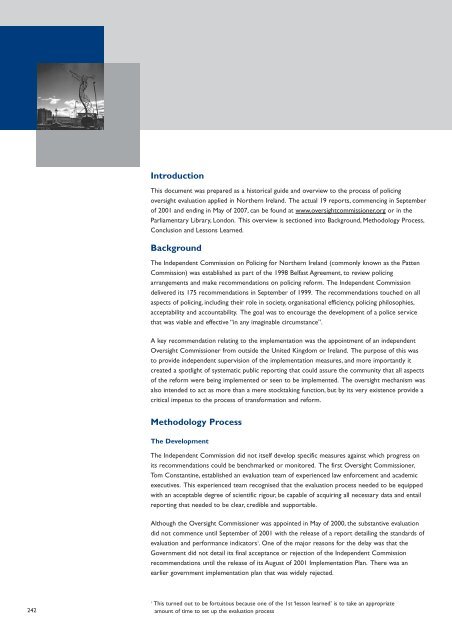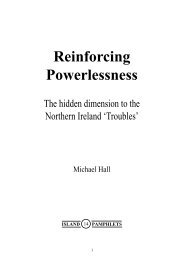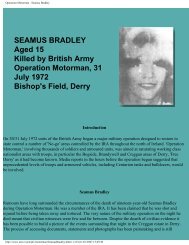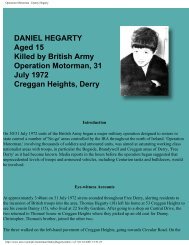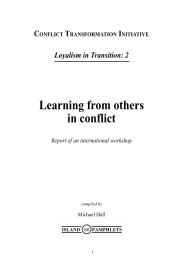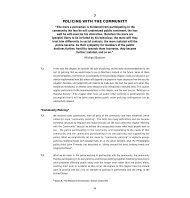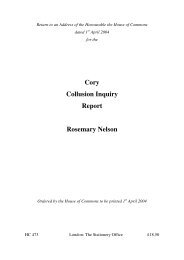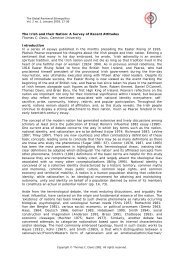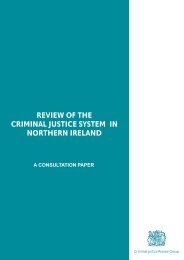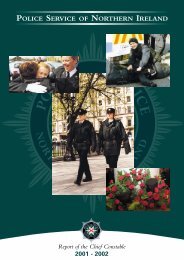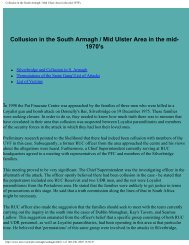11293 report 19 - CAIN - University of Ulster
11293 report 19 - CAIN - University of Ulster
11293 report 19 - CAIN - University of Ulster
Create successful ePaper yourself
Turn your PDF publications into a flip-book with our unique Google optimized e-Paper software.
IntroductionThis document was prepared as a historical guide and overview to the process <strong>of</strong> policingoversight evaluation applied in Northern Ireland. The actual <strong>19</strong> <strong>report</strong>s, commencing in September<strong>of</strong> 2001 and ending in May <strong>of</strong> 2007, can be found at www.oversightcommissioner.org or in theParliamentary Library, London. This overview is sectioned into Background, Methodology Process,Conclusion and Lessons Learned.BackgroundThe Independent Commission on Policing for Northern Ireland (commonly known as the PattenCommission) was established as part <strong>of</strong> the <strong>19</strong>98 Belfast Agreement, to review policingarrangements and make recommendations on policing reform. The Independent Commissiondelivered its 175 recommendations in September <strong>of</strong> <strong>19</strong>99. The recommendations touched on allaspects <strong>of</strong> policing, including their role in society, organisational efficiency, policing philosophies,acceptability and accountability. The goal was to encourage the development <strong>of</strong> a police servicethat was viable and effective “in any imaginable circumstance”.A key recommendation relating to the implementation was the appointment <strong>of</strong> an independentOversight Commissioner from outside the United Kingdom or Ireland. The purpose <strong>of</strong> this wasto provide independent supervision <strong>of</strong> the implementation measures, and more importantly itcreated a spotlight <strong>of</strong> systematic public <strong>report</strong>ing that could assure the community that all aspects<strong>of</strong> the reform were being implemented or seen to be implemented. The oversight mechanism wasalso intended to act as more than a mere stocktaking function, but by its very existence provide acritical impetus to the process <strong>of</strong> transformation and reform.Methodology ProcessThe DevelopmentThe Independent Commission did not itself develop specific measures against which progress onits recommendations could be benchmarked or monitored. The first Oversight Commissioner,Tom Constantine, established an evaluation team <strong>of</strong> experienced law enforcement and academicexecutives. This experienced team recognised that the evaluation process needed to be equippedwith an acceptable degree <strong>of</strong> scientific rigour, be capable <strong>of</strong> acquiring all necessary data and entail<strong>report</strong>ing that needed to be clear, credible and supportable.Although the Oversight Commissioner was appointed in May <strong>of</strong> 2000, the substantive evaluationdid not commence until September <strong>of</strong> 2001 with the release <strong>of</strong> a <strong>report</strong> detailing the standards <strong>of</strong>evaluation and performance indicators 1 . One <strong>of</strong> the major reasons for the delay was that theGovernment did not detail its final acceptance or rejection <strong>of</strong> the Independent Commissionrecommendations until the release <strong>of</strong> its August <strong>of</strong> 2001 Implementation Plan. There was anearlier government implementation plan that was widely rejected.2421This turned out to be fortuitous because one <strong>of</strong> the 1st ‘lesson learned’ is to take an appropriateamount <strong>of</strong> time to set up the evaluation process


